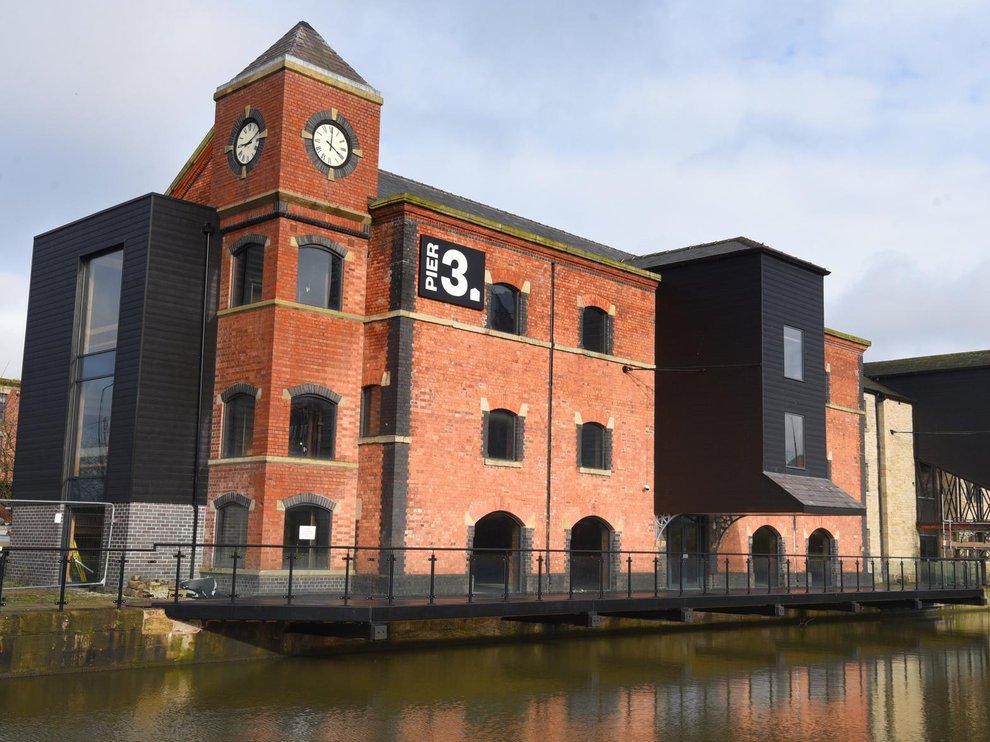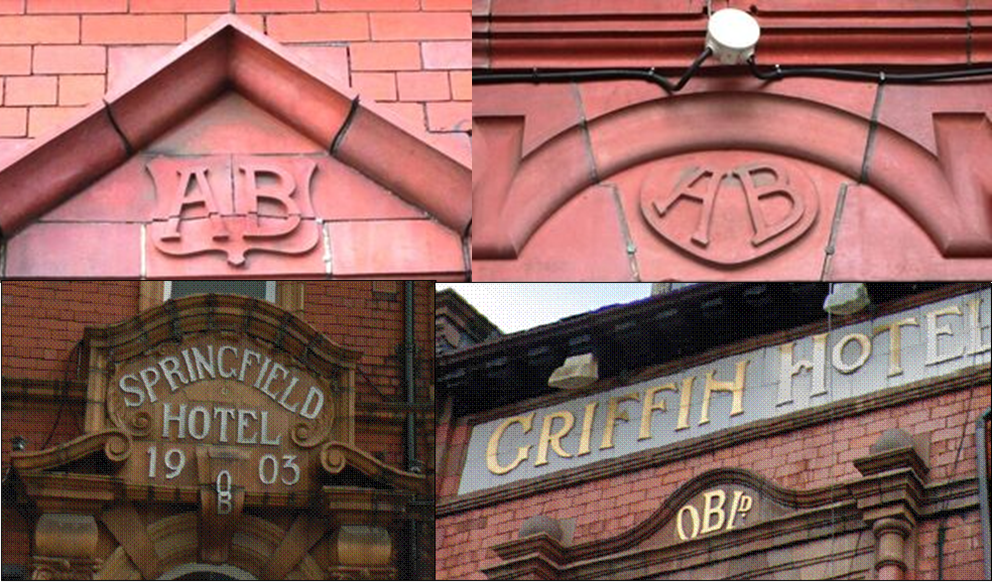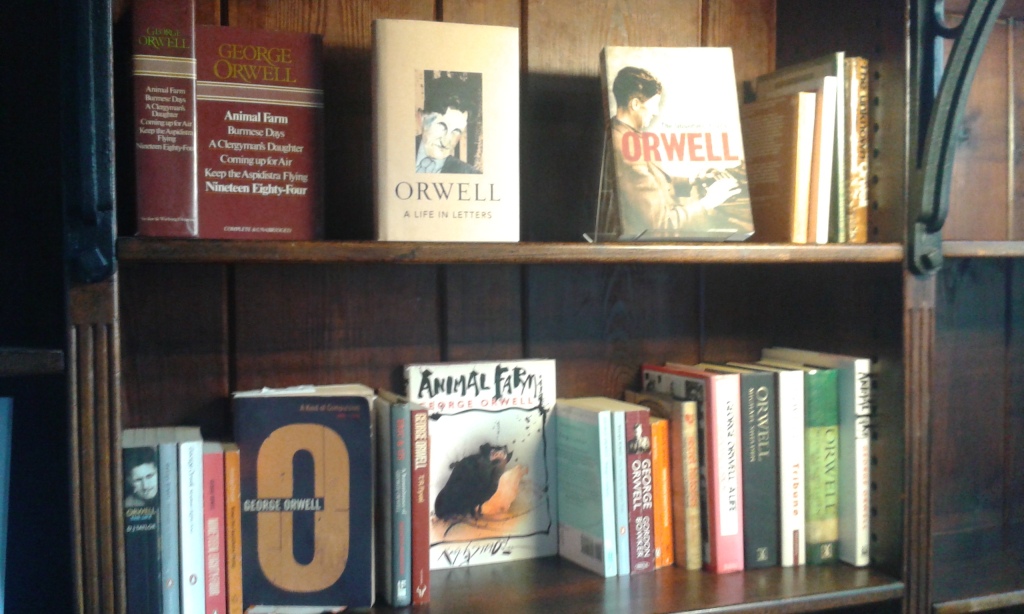A pier – sorry – Peer at Wigan.
If you were to hear the word `Wigan’, what would come into your mind as far as this town is concerned?
Let’s put that another way.
What is the collective noun for natives of Wigan?
Give yourself ten out of ten if you said `Wiganers’. But also give yourself full marks if your answer is `Pie-Eaters’…
Wigan has a reputation for being the pie-eating capital of the Universe. It is even acknowledged by this artwork, which I snapped at Wigan Museum when I visited last Saturday:

I remember once seeing a photograph of people queuing out of the doors at a pie-shop called Arkwright’s; Higginbottom’s; Postelthwaite’s Perfect Pies or something Suitably Northern with the caption: “Black Friday in Wigan”.
Is this reputation for pie-eating deserved, though – or is it a bit of a myth?
Here’s David Barnett, a Wigan-born journalist who once wrote the following in the Guardian:
Some years ago I brought an entire newsroom to a standstill. This wasn’t, sadly, due to any stunning journalistic achievement. I was simply having my lunch. And it was a pie barm.
I didn’t even know I’d done anything until I became aware of the slow draining away of the hubbub that typifies a local newspaper office at midday. I looked up from what I was doing – tapping at my keyboard with one hand, pie barm in the other – and realised everyone was staring at me. Then they began to leave their desks, to walk over to mine, until I was surrounded by uncomprehending faces. What, they wanted to know, was I eating?
I blinked and looked at the meat-and-potato pie sandwiched between a buttered white roll. It was just a pie barm. I looked behind me to see if there was someone eating something exotic and outrageous. But no. It was me. Me and my pie barm.
But when you’re from Wigan, you never really stop eating pies. You might be said to be resting, or in remission, or recovering. Eating pies is part of our DNA, our heritage, our birthright. And a pie barm – also fondly known as a Wigan Kebab – is the epitome of our gastronomic culture.
I don’t want to teach David or his Grandma how to suck eggs but I think he has got his terminology a little bit mixed-up.
The thing he has described as a `Wigan Kebab’ is apparently actually a `Wigan Slappy’. (A pie slapped between two slices of invariably white, buttered bread.) A Wigan Kebab is apparently no less than three pies impaled on a skewer and considered to be a local delicacy.
The Manc takes-up the story:
The town’s penchant for pastry is everywhere. I noticed it from the moment I first set foot in Wigan’s sport stadium as a kid – from the pie posters slapped across the walls of the concourse to the pastry offer announcements crackling across the PA system. An advert for ‘POOLE’S PIES!’ (a company which produced pies in Wigan for 171 years) even danced its way across the scoreboard during the game. Poole’s has sadly folded since then. But there’s still a minimum of 20 listed pie shops operating in the Wigan region today (with dozens of local cafes and food stores serving up pies as part of their wider menus). Since 1992, Wigan has also been the prideful host of the World Pie-Eating Championships – where contestants aim to wolf down as many of these crumbly concoctions as quickly as possible (historically held at Harry’s Bar on Wallgate).Ahead of the 2016 edition of the competition, a pie was launched into space to commemorate the occasion.
(I wonder if it was a Potato Pie – you know: a Spudnik…)
Anyway – there we have it. Oh – other than Baldy’s pies (which are cooked on Clayton Street in the town) are apparently the best available these days. (That plug must be worth a Free Sample or two, mustn’t it?)
Maybe not. The brilliantly entitled Life of Pies website has its Top Ten of Wigan pies in which Baldy’s doesn’t even get a mention. Here it is:
(For anyone likely to watch either soccer or Rugby League in the town in the future, you might like to make a note of this:
“6. Rolling Pin. Based just a stone’s throw * from the DW Stadium in the heart of Newtown, it’s a shame more visiting fans don’t get the chance to sample these fine pies instead of the overpriced Hollands they sell at the ground. A sturdy, golden crust gives way to sloppy potato filling and tasty pinkish ringlets of mince in their meat and potato pie which is a true throwback to yesteryear. (*if you’ve got arms like Geoff Capes.)”
Ah – I almost forgot. This is a picture of Wigan Athletic’s Mascot – as chosen by their own supporters. What do you think his (or her) name might be?

At Morecambe, we’ve got Crusty –sorry, Christie the Cat; Wigan Athletic have got Crusty the Pie…
I was in the centre of Wigan prior to the Latic’s demolition of Morecambe by four goals to one last Saturday.
Match Report at
There, I discovered a cafe in the large indoor Market which promised the hungry punter a delicacy I have never come across before – anywhere. It was a `Cauliflower Cheese Toastie’. (I imagined that this would be a Heart Attack on a plate but thought it could be potentially absolutely delicious – particularly with a smear or two of English Mustard on it.) So, having walked around the town centre for a couple of hours, “Ah wur fair clemm’t”
Pardon?
It means I was rather hungry.
For other examples of Wiganese – such as an observation concerning unfortunate people with large teeth: “Art breighkin um in fer an ‘orse?” – see `Wigan Speyk’ at
https://www.wiganworld.co.uk/stuff/dialect2.php?opt=dialect2
I had already taken-in the sights and smells of their Street Market (where I had discovered a vast range of foods from all over the world).
Ignoring the temptation to buy something else entirely, I went back there to try one of their special Toasties. Sadly, to no avail: they had run out of Cauliflower Cheese…
But the ladies at the cafe were suitably sympathetic to my plight.
“Ast ad thi tay er dust wantsum?” they said.
(They didn’t really…)
So what other culinary delights is Wigan famous for? Something sweet this time. Want a clue? OK – here it is: Uncle Joe.
No, not `Uncle Joe’ Stalin (although Wigan has certainly had plenty of admirers of the Soviet tyrant among their inhabitants over the years) but one produced by a company called Santus and whose factory can be found near the railway stations. They produce such delights as Uncle Joe’s Mint Balls which are so popular that you can buy empty tins to hold them in, as shown in this picture of a sweet shop in one of the town’s numerous Arcades:

What else is Wigan famous for?
It has to be its Rugby League Club.
“Three Points to Wigan!” is an expression that has entered the national consciousness. The club – known these days as Wigan Warriors – merits its own exhibition at the town’s Museum (entrance through a red-painted turnstile from their old ground at Central Park.)
Rightly so: Wigan is the most successful English Rugby League club of all time and has produced some of its greatest players, from legendary Billy Boston (whose statue can be found in the middle of the town just off The Wiend) to Ellery Hanley and Andy Farrell in more recent times.

So what else are we left with as far as Wigan is concerned?
Culture?
Cheeky Chappie George Formby – with his little Ukulele in his hand – came from Wigan. He was one of the first genuinely funny stars of the Silver Screen. His humour was always slightly risqué – but acceptable to the Lord Chancellor’s Office, who censored things like this at the time.
Not so that of his contemporary Frank Randle, who was born in Wigan Borough at Aspull in 1901 to an unmarried mother – a scandal at the time. Scandal – Randle – the two words went together and he toured as a comedian presenting Randle’s Scandals before he found greater fame – or notoriety – in film. Frank’s humour was far more anti-Establishment and arguably even subversive than George Formby’s ever was and he had several run-ins with the Chief of Police in Blackpool during the 1950s, who had him both banned and arrested several times for alleged obscenity in his stage acts on the piers and theatres of the resort. He died there, bankrupt and apparently both alcoholic and quite dissolute, very sadly, during 1957.
Given the earnestness with which all media in the UK – particularly the BBC – are currently trying to divulge themselves of any association with their racist and misogynistic pasts, it might be instructive to watch Frank’s 1953 film It’s a Grand Life . In this, Diana Dors – one of the first genuine British Sex Symbols – is a co-star. But extraordinarily talented black female pianist Winifred Evans is also heavily featured right at the end of the film.
Where else could you have heard of her at the time? Well – not on the BBC for a start…
You can see the whole film here:
I personally suspect that Frank was simply ahead of his time…
But let’s go back to George Formby. Are there any other Georges with a link to Wigan which you can think of? Someone who wrote about Wigan way back in the 1930s, for instance?
George Orwell is actually a Pen Name. The writer of such famous tomes as The Road to Wigan Pier was actually an Old Etonian whose real name was Eric Blair. At the time, the idea that any of the masses of people actually from Wigan might express their own thoughts about the town they lived in were considered to be preposterous by The Powers That Be. You can just imagine it, can’t you?:
“Good Lord – have you ever heard any of these barbarians actually speak, old boy? If you have, you will know that these people can barely express themselves in English, let alone put pen to paper to write anything even vaguely sensible – let alone profound or insightful – in said language. Any sensible chap can see that the proper way to understand the real situation of the Northern English Working Class is to ask a man from the Southern Elite to live among them for a relatively short time and then report back about the experience. Obviously!”
So – just before the Second World War – Eric Blair did. He had the luxury – it goes without saying – of being able to return to the privileged life he had led up until that point. And – once he’d had enough of the grinding poverty which was a Life Sentence for the people he briefly lived amongst – he duly did so.
If you choose to actually read Orwell’s words – well; pontifications, really – about Wigan, I promise you a book utterly dreary and very, very boring. Try Animal Farm instead: it is both a much better read and it is also (mercifully) far shorter… The man who wrote it might have had his heart in the right place. But he had about as much idea about the real struggles of the Working Class he was parachuted in to live amongst as his fellow Southerner and Old Etonian who is in charge of `levelling-up’ in our country at this moment in time has. And – before you ask – Boris is definitely not from Wigan…
Anyway… Wigan Pier was actually a wharf on the Leeds to Liverpool Canal where the coal hacked from the neighbouring countryside was loaded onto barges to fire-up the factories spawned by the Industrial Revolution all around Lancashire and Yorkshire. Alternatively, the canal allowed the Black Gold to be exported all over the world from the docks at the mouth of the Mersey.
I walked past it on the way back from Morecambe’s defeat by Wigan Athletic the other day and it’s huge. I didn’t have time to visit – and even if I had, I don’t think the recent redevelopment of this site is finished yet. The Wigan Post provides this photograph of just a small portion of the `Canal Quarter’:

The redevelopment will include things like a Microbrewery. This could hardly be expected to replace any of the large Breweries which Wigan once boasted: Airey’s; Albion Brewery (which had 24 tied houses in the town alone); James Fairhurst; Oldfields (29 pubs in central Wigan)and Henry Robinson’s (28 tied houses in Wigan itself)for example.
No trace of these Breweries can be found in the vicinity anymore except the occasional unexplained initials of the defunct companies in a random pub’s brickwork. Here are two from `AB’ – Albion Brewery and (under the date) two `OB’ and `OBLd’ which both once belonged to Oldfield’s Brewery Ltd:

At the Pier, though, there will also be some sort of tribute to the man who put it on the map in the first place. Before the Morecambe game, I had found time to visit Wigan Museum. Here, George Orwell has a corner of the Reading Room upstairs dedicated specifically to him:

So – what else is Wigan famous for?
Oops – I’ve just given it away by writing about `coal hacked from the neighbouring countryside’.
I’m so ancient that I can actually remember `Wiggin’ when it was even more famous for coal mining than it was for Rugby League. In the 1920s, sixty-five collieries could be found in the Wigan Coalfield. Forty years later, I can remember seeing a huge spoil heap towering like a mountain to the east of an unfinished M6 to the west of the town. This was apparently excavated and moved to fill-in the gaps needed to lift the same road onto the level (more or less) across valleys and dips in the motorway as it ploughed its way remorselessly northwards through Cumbria during the 1970s.
You could still see loads of Pit Head machinery in Wigan and its environs right up until the 1990s, when Margaret `Milk Snatcher’ Thatcher shut them all down. This wasn’t due to any environmental considerations the Tory Prime Minister might have had: she wasn’t trying to save the planet. It was a matter of simple political revenge: the Miners and their union – the NUM (National Union of Mineworkers) – had brought-down her predecessor as Tory leader of Britain, Ted Heath. They weren’t going to do it to her, whatever the economic and social cost to the country and the Miners themselves. But we must remember, to quote the Iron Lady herself: “There is no such thing as society”. So that’s all right, then.
Mining takes us back Full Circle again to pies. Cornish Pasties were invented by the wives of Cornish Tin Miners because they were an excellent way to get decent nutrition to men working in filthy and dangerous conditions far underground. It has been claimed that the term `eating Humble Pie’ has its origins in Wigan. Miners from the Wigan coalfield were the first to return to work once the government had basically starved them into submission during the National Strike of 1926.
The NUM went on strike again as Mrs Thatcher started to deprive Miners right across Britain of their livelihoods throughout the 1980s. In Wigan’s Museum, there are many mementos of this time, including plaques to commemorate the closure of individual coal mines. There is also a framed poster parodying the Conservative government’s insistence at the time about the primacy of something they called `Victorian Values’. (This was a concept which came completely unstuck when it turned-out that local Carnforth Lad and Thatcher favourite Cecil Parkinson – who had bleated on endlessly about the values of high ethical standards – had fathered an illegitimate child in an adulterous relationship whilst serving in the government):

In case this is not clear, the photograph shows a mounted policeman about to strike a woman – photographer Lesley Boulton – on 18th June 1984 during the Orgreave Coking Plant protest:

The poster in the Museum contrasts this image with a view of the Peterloo Massacre in Manchester of 1819 which involved the death of eighteen people – including four women and a child – and injuries to as many as 700 others as they were literally cut-down by other representatives of the state at the time. (In case you’re interested, the fearless Upholder of Law and Order on horseback in the photograph missed when a bystander pulled Lesley and her camera out of the way at the very last moment.)
But let’s move quickly on. Although they will always live in the shadow of the Rugby League club whose ground they share, Wigan Athletic is worth a mention all of its own. Back in the 1960s, they were playing in the obscurity of the Northern Premier League on a level par with Morecambe. Since then, though, the Latics have played in every Division of the EFL and reached the mighty heights of the Premiership in 2005. Even more amazingly for a relatively small club, they beat overwhelming favourites Manchester City in the FA Cup Final during 2013 – and were promptly then relegated as well. Dave Whelan was born in Bradford but grew-up in Wigan and started his phenomenal retail career – following a serious injury which ended his days as a professional footballer plying his trade at the highest level in England – on a stall in the Market there. The statue of him which features outside the DW (Dave Whelan) Stadium which Athletic now share with Wigan Warriors is a fitting tribute to a man who turned a Cheshire League club playing at run-down Springfield Park into a member of the elite of English soccer in recent times. Skulduggery off the field since Dave and then his son relinquished control of the club has seen Wigan relegated once more and even face financial extinction altogether in recent times, though. But now they seem to be back on track and heading for the Championship yet again.
Good luck to them. I have always had a strong affection for their club, which has done even greater things from the same humble beginnings than Morecambe FC have been able to. I’ve also yet to meet a Pie-Eater Wiganer who I haven’t personally taken to.
Wigan is a remarkable place. The Town Motto is Progress with Unity. Maybe it‘s time for a change, though – with all deference to the website I have already quoted in this article and with due apologies to Yann Martel and his extraordinary book – to The Life of Pies…
What do you think?